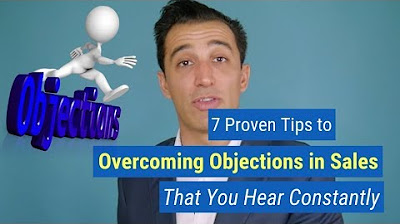9 Minute Training To Destroy Any Sales Objection
Summary
TLDRThis sales training script delves into overcoming common objections by using reframing techniques. The speaker emphasizes the importance of addressing a prospect's fears and emotional triggers, such as the consequences of inaction, rather than merely focusing on the product. Through role-play, the trainer demonstrates how to deframe a prospect's objections by asking thought-provoking questions that make them reflect on their situation, shifting their mindset. The goal is to help prospects recognize the urgency of their decision and the potential negative impact of delaying action, ultimately leading to more effective sales conversations.
Takeaways
- 😀 Understanding objections is crucial in sales; common ones include 'I don't have the money,' 'I'm not sure it will work,' and 'I'll do it later.'
- 😀 You need to deframe your prospects by challenging their current mindset using strategic questions that encourage self-reflection.
- 😀 Asking an open-ended, consequence-driven question like, 'How can I communicate to you that you might be making a mistake without upsetting you?' helps to reframe the prospect's thinking.
- 😀 The emotional drivers that influence change are pain and the fear of future pain. Highlighting the consequences of inaction motivates prospects to act.
- 😀 To prevent objections, focus on getting prospects to feel the pain of their current situation and the fear of future consequences.
- 😀 Identity framing plays a key role in reframing a prospect’s mindset. You can ask questions that challenge their self-image and make them want to avoid negative outcomes.
- 😀 The goal is not to sell immediately but to help the prospect recognize the deeper reasons behind their hesitation and get them to persuade themselves.
- 😀 Using a concerned tone while asking questions helps lower the prospect's defenses and make them more open to considering the consequences of inaction.
- 😀 Urgency can be built by discussing the potential worsening of their situation if they delay making a decision.
- 😀 Empathy and care are essential in sales. By showing concern for the prospect’s future, you can make them feel understood and more willing to act.
- 😀 Instead of fighting objections directly, you should guide the prospect through a process of self-persuasion by using emotional triggers and reframing techniques.
Q & A
What is the primary sales technique discussed in the transcript?
-The primary technique discussed is reframing, where the salesperson helps the prospect see the potential negative consequences of inaction, encouraging them to make a decision now rather than later.
How does the salesperson address common objections like 'I don't have the money' or 'It's not the right time'?
-The salesperson uses a technique called deframing, where they ask questions that challenge the prospect's current frame of mind. This encourages the prospect to consider the long-term consequences of their inaction, making them rethink their objections.
What is the significance of asking a prospect, 'How can I communicate to you that you might be making a mistake without you getting upset with me?'
-This question is used to gently challenge the prospect’s position while demonstrating concern. It triggers doubt in the prospect's mind and lowers their guard, making them more receptive to a shift in perspective.
How does the concept of 'pain' and 'fear of future pain' play a role in the sales approach?
-The sales approach centers around making the prospect experience their current pain and envision future pain if they don’t act. This emotional trigger creates a sense of urgency and encourages the prospect to change by highlighting the negative consequences of inaction.
Why does the salesperson emphasize the importance of timing in the conversation, asking 'Why not push it down the road like other executives?'
-This question is designed to get the prospect to reflect on their identity and future. By contrasting the prospect's potential future with that of others who procrastinate and suffer, the salesperson encourages them to take action now and avoid being like those executives who fail to act.
What role does tone play in the reframing process?
-Tone is crucial as it helps communicate concern and sincerity, which triggers the prospect’s subconscious to lower their defenses. The concerned tone seeds doubt in the prospect’s mind, making them more open to considering the salesperson’s point of view.
How does the salesperson address the prospect's fear of making a wrong decision?
-The salesperson addresses the fear of making a wrong decision by using questions that subtly shift the prospect’s focus to the possible negative outcomes of inaction, thus making them reconsider their position without feeling directly confronted.
What is the purpose of creating a scenario where the prospect’s spouse is involved in the conversation?
-Involving the spouse in the conversation adds emotional weight to the decision. It connects the prospect’s personal and professional life to the consequences of their inaction, encouraging them to think about their responsibility to their family and not just themselves.
What is meant by an 'identity frame' in the context of this sales approach?
-An identity frame refers to the way a person sees themselves. By asking the prospect if they want to be like executives who never address their health and fail to get promoted, the salesperson challenges the prospect's self-image and encourages them to act in a way that aligns with their desired identity.
How does the salesperson ensure they don't sound too pushy when deframing the prospect's objections?
-The salesperson uses a soft, concerned tone and asks open-ended questions that make the prospect reflect on the consequences of their decisions. This approach ensures the prospect feels respected and not pressured, making them more likely to engage and reconsider their stance.
Outlines

This section is available to paid users only. Please upgrade to access this part.
Upgrade NowMindmap

This section is available to paid users only. Please upgrade to access this part.
Upgrade NowKeywords

This section is available to paid users only. Please upgrade to access this part.
Upgrade NowHighlights

This section is available to paid users only. Please upgrade to access this part.
Upgrade NowTranscripts

This section is available to paid users only. Please upgrade to access this part.
Upgrade NowBrowse More Related Video

The 5-Step Process to Overcome Any SMMA Objection

Stop Believing Buyer Excuses (Here’s What to Say Instead)

MCdistrict Workshop - Answering Objections with Brian Carter

How To Overcome Any Sales Objections - Best Sales Objection Handling Techniques

7 (Proven) Tips to Overcoming Objections in Sales That You Hear Constantly [Avoidance]

How To STOP A Sales Objection Before It Starts
5.0 / 5 (0 votes)